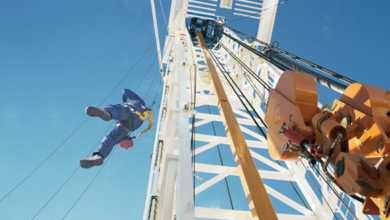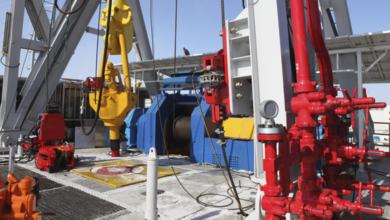Drilling & Completion Tech Digest
Petrobras bumps July gas output up 8% in Brazil

Petrobras’ Brazilian natural gas output increased by 8% in July compared with the same month a year ago, up to 56.71 million cu meters/day. With oil, the country averaged 2,325 million bbl/day of oil equivalent in July.
In August, Petrobras said it put the semisubmersible platform P-56 into operation in the Campos Basin’s Marlim Sul Field in the state of Rio de Janeiro. The unit went into production from well 7-MLS-163HPRJS, which can produce up to 16,000 bbl/day.
Installed at a water depth of 1,670 meters, the new platform was designed to process up to 100,000 bbl/day of oil when it reaches full capacity, which is expected in Q1 2012. In addition to heavy oil, P-56 is capable of processing and treating up to 6 million cu meters/day of natural gas.
The platform will be interconnected to 21 wells, 10 of which are oil producers and 11 are water injectors. Oil will be transported by pipeline to platform P-38, an FSO unit (floating oil and gas storage and offloading system) anchored 20 km away from P-56. From the P-38, the oil will be transported on shuttle tankers, and the natural gas will be piped to Cabiúnas terminal.
To prove local manufacturing capability, the P-56 hull was entirely built in Brazil.
WesternGeco begins Dual Coil Shooting survey
WesternGeco recently started the Revolution II multiclient survey in the highly prospective Green Canyon area of the Central Gulf of Mexico. The Revolution II multiclient survey will provide full-azimuth (FAZ) coverage on more than 3,200 sq km or 140 Outer Continental Shelf (OCS) blocks.
Building on multi- and wide-azimuth techniques, Dual Coil Shooting is an advanced method of acquiring full-azimuth, ultra-long offset marine seismic data using four vessels following a circular path. This method allows the fleet to focus imaging on specific areas of client interest.
Dual Coil Shooting provides better target illumination in challenging environments by enabling greater azimuthal coverage and a higher signal-to-noise ratio. WesternGeco will apply advanced seismic data processing techniques to the survey.
Revolution II builds on the FAZ acquisition of Revolution I in the Western Gulf of Mexico acquired in late 2010.
CNPC’s Baoji produces China’s 1st high-strength H-level drilling riser
On 8 August, China National Petroleum Corp (CNPC) subsidiary Baoji Petroleum Steel Pipe Company produced China’s first high-strength H-level marine drilling riser. Test results showed that all the mechanical performance indexes of the riser were in compliance with the rules and standards in DNV OS F101 Submarine Pipeline Systems.
Separately, another manufacturing arm of CNPC, Baoji Oilfield Machinery Co (BOMCO), has signed an agreement with Brazilian companies BRCP and ASPERBRAS to establish an oil equipment joint venture (JV). The JV, signed in Beijing on 16 July, is the first of its kind between a Chinese oil company and Brazilian companies in the oil equipment manufacturing sector. Located in Salvador city in Bahia, Brazil, the JV is expected to become operational in October. BOMCO will have 34% stake while BRCP and ASPERBRAS will each hold 33%.
Liner drilling system saves offshore well
Baker Hughes’ liner drilling system was used to save an offshore well, saving $7.5 million in mud and nonproductive time losses. An operator was unable to drill through a complex micro-fractured formation because tools and drilling fluids were being lost in the hole. After three sidetrack attempts, the operator was considering plugging and abandoning the well. Baker Hughes suggested a liner drilling solution using a TORXS expandable liner hanger packer system with an EZCase casing bit system to drill the section.
The objective was to drill 40 m (131 ft) from 3,230 meters to 3,270 meters (10,597 ft to 10,728 ft) to case and isolate the difficult zone. Baker Hughes drilled the hole, set the liner and the liner top packer in one trip. Due to different pore pressure zones, the customer was also able to drill the next section with water-based mud rather than oil-based mud.
Baker Hughes completes 1st multistage shale fracking in Argentina
Baker Hughes recently completed its first unconventional hydrocarbon shale hydraulic fracturing and stimulation project in Argentina for YPFin the Neuquén basin. The multistage fracturing operation was performed using more than 12,000 hydraulic horsepower and a total fluid volume exceeding 7,000 cu meters.
YPF is evaluating well results to determine the potential for expanding operations. Several operators are developing and executing exploration plans in Argentina’s unconventional hydrocarbon plays.
“While the bulk of unconventional shale activity has been in the US, interest in shale plays in other parts of the world are beginning to expand, and indications are that Argentina will be a promising area for international success,” Rod Larson, president of Latin American operations for Baker Hughes, said. “We are positioning our operations in Latin America to support this new market, and we are leveraging our capabilities and lessons learned in the US to help operators in Argentina.”
Baker Hughes also provided coiled-tubing services for the project.
Field-tested stage multiplier technology allows fracturing up to 60 stages per lateral

Packers Plus Energy Services recently released the RepeaterPORT sleeve, which enables fracturing of up to 60 stages per lateral, according to the company. The stage multiplier technology increases the number of stages available in the company’s StackFRAC HD system. By using the same-size ball, the RepeaterPORT sleeve multiplies the number of available stages that can be fractured, allowing for optimization of fracture crews and the use of less frac fluid. There are a variety of ball seat sizes, allowing numerous stages to be run in sequence, the company said.
“We can actually drop the same-size ball multiple times and activate specific ports within the system,” Packers Plus president Dan Themig said.
The RepeaterPORT has been field-tested in the US and is available worldwide.
Apache’s Forties well IP highest in field since 1990
Apache Corp’s Charlie 4-3 development well on the Forties field in the UK sector of the North Sea, completed in June, commenced production at a rate of 12,567 bbl/day of oil. This is the highest initial production (IP) rate on the Forties since 1990 and follows the previously disclosed Charlie 2-2, which was completed in March with an IP rate of 11,876 bbl/day.
Apache acquired a new 4D (time-lapse) seismic survey over Forties in 2010, which enhanced the company’s ability to identify accumulations of bypassed oil. Charlie 4-3 and Delta 3-5, the eighth and ninth development wells brought on production at Forties during 2011, targeted two of these accumulations. Delta 3-5 commenced production at 8,781 bbl/day. Additional 4D driven targets are being identified. Apache expects to drill 16 wells on the Forties field during 2011. When Apache acquired Forties in 2003, the field was producing 40,000 bbl/day. With the onset of these new wells in mid-June, gross daily production rates have reached as high as 70,000 bbl of oil equivalent.
GE Oil and Gas to supply TLP tensioner system to Chevron Big Foot
GE Oil & Gas’ Drilling & Production business has received a contract of approximately $45 million to supply and service the industry’s largest tension leg platform (TLP) marine riser tensioner systems to Chevronfor deployment on its Big Foot field in the deepwater Gulf of Mexico.
GE is making key design modifications to develop “push-up” style marine riser tensioner equipment to enable the Chevron Big Foot TLP to deal with the challenging wave and current movement conditions of deepwater applications. “We are utilizing innovative technology to deliver customized ‘push-up’ style TLP tensioners,” Manuel Terranova, senior VP – global regions and sales, Drilling & Production, GE Oil & Gas, said.
The vertically moored floating TLP is suitable for use in a wide range of water depths; to date, TLPs have been deployed in water depths approaching 5,000 ft. The GE-Chevron Big Foot unit will be the first to operate in depths of 5,200 ft.
The Big Foot TLP will be Chevron’s sixth operated facility in the deepwater Gulf of Mexico. It will include an on-board drilling rig and will have a production capacity of 75,000 bbl/day of oil and 25 million cu ft/day of natural gas. Installation of the TLP is scheduled to begin in November 2012, and first oil is expected in 2014.




Why would President Obama act cnorecned during the 2008 campaign he stated that the American People would have to hurt for them to convert to alternate fule. This is exactly what he wants to happen.